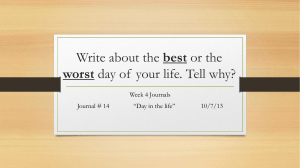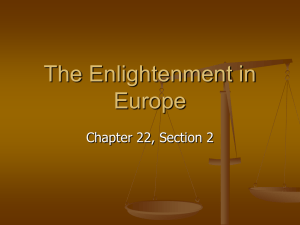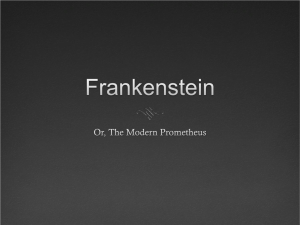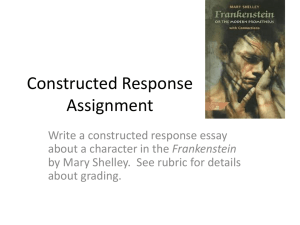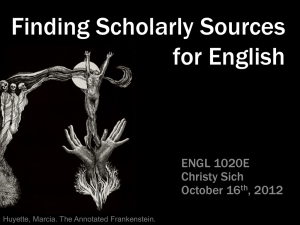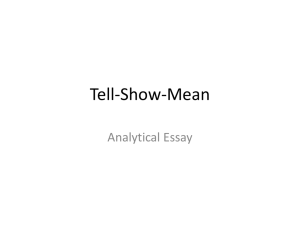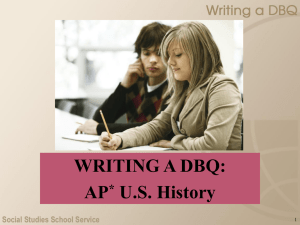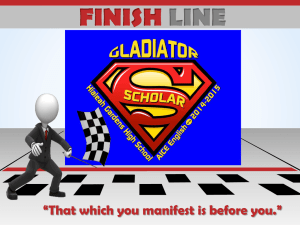quotation: staging analysis
advertisement
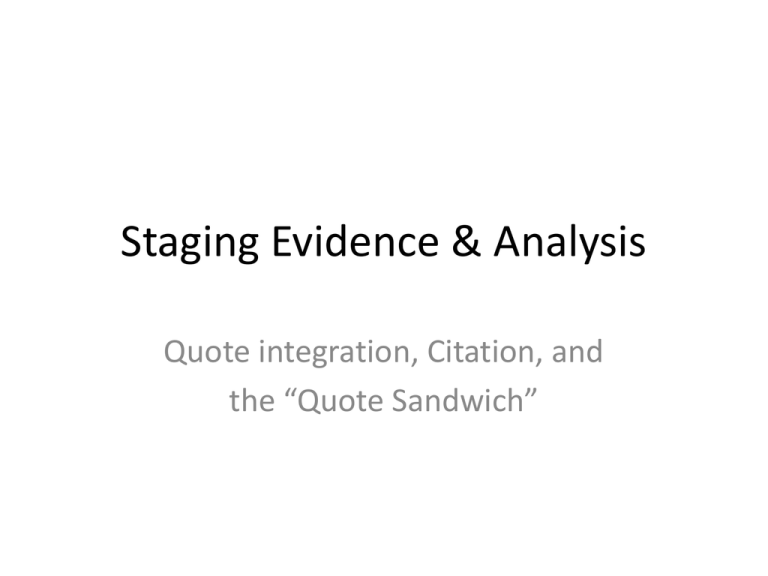
Staging Evidence & Analysis Quote integration, Citation, and the “Quote Sandwich” “Staging” evidence and analysis • We have briefly discussed the importance of evidence and analysis for building arguments. Evidence/Analysis: – Is the foundation of any academic writing – Connect “what everyone can see” to your point/claim/argument – Compose the majority of any paper – “the body” • In Literature Studies, evidence is textual – QUOTES!! The Rules of Quote Integration • GRAMMATICAL/SYNTACTICAL: Always refer to the events of a piece of fiction in the present-tense! NO: Victor Frankenstein lived in Geneva. Yes: Victor Frankenstein lives in Geneva. The Rules of Quote Integration • GRAMMATICAL/SYNTACTICAL: All quotes must be integrated into your paper smoothly and in sync with the syntax of your sentence and paragraph. NO: Victor Frankenstein’s god complex is apparent. “A new species would bless me as its creator and source...” Yes: Victor Frankenstein’s god-complex is apparent when he declares that “a new species would bless me as its creator…” The Rules of Quote Integration • GRAMMATICAL/SYNTACTICAL: All quotes must be integrated into your paper smoothly and in sync with the syntax of your sentence and paragraph. NO: Frankenstein thinks that tranquility is important and “do not think that the pursuit of knowledge is an exception to this rule.” Yes: Frankenstein thinks that tranquility is important and does “not think that the pursuit of knowledge is an exception to this rule.” The Rules of Quote Integration • GRAMMATICAL/SYNTACTICAL: Use brackets [ ] and ellipses … to shape the quote to your needs (but don’t overdo it) No: Walton longs for a companion who would be able to “regulate my mind.” Yes: Walton longs for a companion who would be able to “regulate [his] mind.” Yes: Walton longs for “a friend who would have sense enough… to regulate [his] mind.” MLA Citation • IN-TEXT (two types) Frankenstein says, “I have been blasted in these hopes, yet another may succeed” (Shelley 152). • • If the sentence does not include the authors name cite both author name and page # Citation goes after the quotation mark, but before the period Shelley writes that Frankenstein has “has been blasted in these hopes” (152). • If the sentence includes the author’s name, only page # is necessary MLA Citation • Work Cited List – Full publication information on each cited text – In alphabetical order Shelley, Mary. Frankenstein. Ed. J. Paul Hunter. New York: W.W. Norton, 1996. Print. Spivak, Gayatri Chakravorty. “Frankenstein and a Critique of Imperialism.” Frankenstein. Ed. J. Paul Hunter. New York: W.W. Norton, 1996. 262-270. Print. Consult your MLA Handbook or Purdue’s OWL website for instructions on how to cite other types of texts. Block Quote • If the quoted text is more than 3 lines long BLOCK QUOTE IT! Start like any normal paragraph. Indent the first line and let the rest of the prose fall in normal formatting. But when you get to the quote, start it on a new line and indent the whole quote. “You seek for knowledge and wisdom, as I once did; and I ardently hope that the gratification of your wishes may not be a serpent to sting you, as mine has been. I do not know that the relation of my misfortunes will be useful to you, yet, if you are inclined, listen to my tale.” (Shelley 17) When you start your own analysis again, do not indent the line following the quote (you are not starting a whole new paragraph here. And notice that the citation in the block quote falls outside the punctuation. Close Reading/Quote Sandwich Start by choosing a quote: “You seek for knowledge and wisdom, as I once did; and I ardently hope that the gratification of your wishes may not be a serpent to sting you, as mine has been” (Shelley 17). • What kinds of interpretations can I generate out of this section of text? • What can I say about this that may move towards an argument? Close Reading/Quote Sandwich Isolate and analyze important or interesting elements of the quote: “You seek for knowledge and wisdom, as I once did; and I ardently hope that the gratification of your wishes may not be a serpent to sting you, as mine has been” (Shelley 17). – Starts by drawing a clear parallel between the quests of Walton and Frankenstein on one of the key themes of the novel – the search for knowledge – where Frankenstein speaks from experience – Frames that search as “gratification of your wishes” which interestingly connects it to personal desire/fulfillment and not to other goals like the “betterment of mankind” or “the furthering of human knowledge” – This gratification is also called a “serpent” which suggests that it the fulfillment of these desires might be poisonous or otherwise predatory Close Reading/Quote Sandwich Create a quote sandwich: • INTRO: What does the audience need to know about this evidence in order to understand the import of your analysis? – Where does it occur? Who is speaking and why? – What are the key themes/topics that you are interested in? – What do you want your reader to be looking for in this quote? “You seek for knowledge and wisdom, as I once did; and I ardently hope that the gratification of your wishes may not be a serpent to sting you, as mine has been” (Shelley 17). • Analysis: What are you teaching your reader about this evidence? – What are your conclusions about the meaning or importance of this example? What are your most argumentative points? – How have you arrived at these conclusions starting from what the text actually says? (show your work!) – How does it contribute to your claim? Close Reading/Quote Sandwich Create a quote sandwich: At one point Frankenstein says, “You seek for knowledge and wisdom, as I once did; and I ardently hope that the gratification of your wishes may not be a serpent to sting you, as mine has been” (Shelley 17). Here we can see that Frankenstein is a seeker of knowledge and wants to warn Walton against its dangers. From this passage we can see that Frankenstein thinks he has something to teach Walton. Close Reading/Quote Sandwich In the letters to his sister that introduce the actual events of the novel, Robert Walton describes how Frankenstein sought to preface his own life story as a warning and a lesson. His comments in this section connect his quest for knowledge with Walton’s journey to the North Pole and simultaneously reveal some of Frankenstein’s ideas about what knowledge is. Speaking directly to Walton, Frankenstein expresses this desire to teach. He says, “You seek for knowledge and wisdom, as I once did; and I ardently hope that the gratification of your wishes may not be a serpent to sting you, as mine has been” (Shelley 17). Here, Frankenstein clearly sees little distinction between Walton’s journey and his own, referring to them both as a quest for “knowledge and wisdom” that he has since abandoned. This passage also allows us to see a little of how Frankenstein defines knowledge itself. He equates the quest for knowledge with “the gratification of your wishes,” suggesting that , for him, knowledge begins and ends with personal ambition and desire. In addition, the allusion to this personal desire as “a serpent” continues the idea that knowledge making is a personal endeavor (whose sting will be felt by him alone) while also suggesting that it has a life and agency of its own. Strikingly, this meditation on the ramifications of the quest for knowledge are not framed in relation to larger social or cultural effects (“the good of all mankind”) but instead framed entirely in the context of individual action, desire and injury. RECAP on Analysis • Quote Sandwich = Analysis Paragraph • Make specific observations about your evidence (the quote). • Organize your analysis – Start with simple points and observations and leave the more complex ideas for the end. – “Add up” your points as your go so that you end up with to a central point. Organizing Your Analysis Frankenstein’s creature receives a very different education than his creator. A major portion of his story centers on the lessons he learns while observing the De Lacey family from hiding. After acquiring language and hearing about “the strange system of human society,” he learns a different set of “lessons” (Shelley 83). Other lessons were impressed upon me even more deeply. I heard of the difference of the sexes; of the birth and growth of children;… how the mind of youth expanded and gained knowledge; of brother, sister, and all the various relationships which bind one human being to another in mutual bonds. (Shelley 84) Whereas Frankenstein’s education is characterized by an encounter with archaic knowledge in the context of a supportive family, the creature’s education includes an introduction to the “bonds” that “bind” humans together. The creature experiences his own “inhumanity” with a new clarity, realizing that he is bound to no one in this manner and can only observe their intimacy from the outside. One of the things he learns is how young people are educated, even as he educates himself through reading and rational observation of his surroundings. The ability to seek education is described as a defining attribute of human beings, but the novel complicates this definition by granting the monster a fantastic capacity for reason and self-knowledge. Organizing Your Analysis A major portion of the creature’s story centers on the lessons he learns while observing the De Lacey family from hiding. After acquiring language and hearing about “the strange system of human society,” he learns about a different system of relationships (Shelley 83). Other lessons were impressed upon me even more deeply. I heard of the difference of the sexes; of the birth and growth of children; how the father doted on the smiles of the infant, and the lively sallies of the older child; how all the life and cares of the mother were wrapt up in the precious charge; how the mind of youth expanded and gained knowledge; of brother, sister, and all the various relationships which bind one human being to another in mutual bonds. (Shelley 84) The De Lacey family serves as an introduction to what the creature identifies as the “bonds” that “bind” humans together. Beyond the simple fact of biology, these fundamental “bonds” are described as a series of gendered roles, with particular expectations for how mothers and fathers conduct themselves and how the family itself should be structured. The creature experiences his own “inhumanity” with a new clarity, realizing that he is bound to no one in this manner and can only observe their intimacy from the outside. In this way, gendered roles become a central part of the definition of what is “human” (and what is not). From this time Elizabeth Lavenza became my playfellow, and, as we grew older, my friend. She was docile and good tempered, yet gay and playful as a summer insect. Although she was lively and animated, her feelings were strong and deep, and her disposition uncommonly affectionate. No one could better enjoy liberty, yet no one could submit with more grace than she did to constraint and caprice. (Shelley 20) No one can conceive the variety of feelings which bore me onwards, like a hurricane, in the first enthusiasm of success. Life and death appeared to me as ideal bounds, which I should first break through, and pour a torrent of light into our dark world. A new species would bless me as its creator and source; many happy and excellent natures would owe their being to me. No father could claim the gratitude of his child so completely as I should deserve their’s. (Shelley 33) Peer Workshops • GOAL: to be helpful! – BE OPEN: new perspectives and ideas enrich the analysis, so be eager to incorporate the ideas of others, including their criticism. – BE CRITICAL: criticism is a form of help, but should be accompanied by encouragement and suggestions for improvement. • Activity: 1. Annotate the quote/Construct at least 2 analytic points. 2. Switch worksheets/Make your own observations/analyses. 3. Save time to discuss your findings together.
